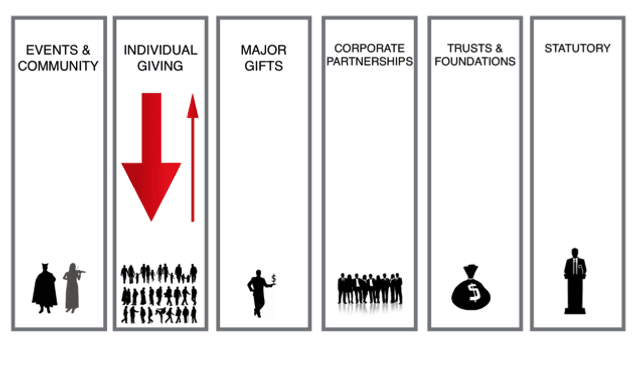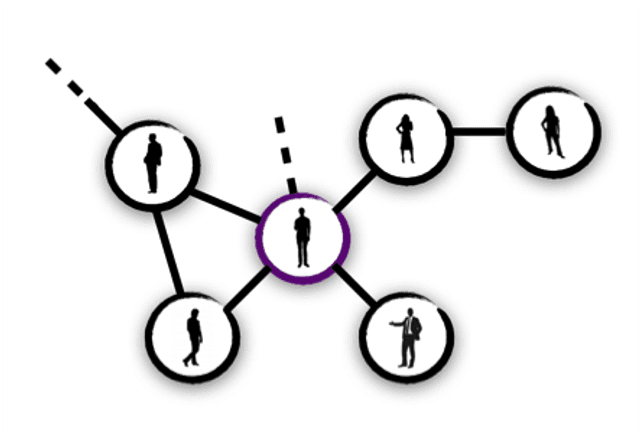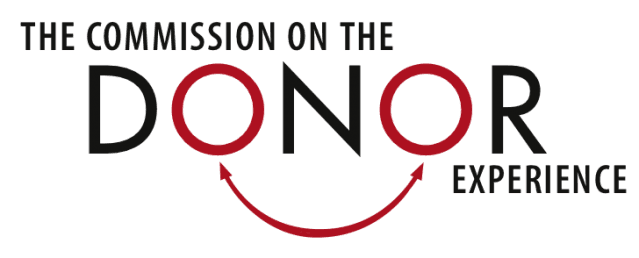A new approach to fundraising – why you should be accessing your donors’ networks
- Written by
- Richard Turner
- Added
- January 21, 2016
 View original image
View original image
Our current fundraising model is like this: we have different areas of fundraising from community fundraising to statutory funding and everything in between: major donors, trusts and foundations, corporate fundraising, corporate partnerships and, of course, individual giving. They are, largely, in separate units - we even talk of ‘silos’. Each is often judged on its direct return on investment. Some like individual giving are broken into sub units of donor recruitment and donor development, sometimes with special subsets like legacies.
Individual giving is judged on its ability to raise the maximum from donors. To achieve this fundraisers must grow their donor base to replace donors who decide not to give any more. The objective for fundraisers is to get money from donors through various means: one-off gifts, regular gifts, upgrades, high-value gifts and ultimately a legacy. So we target the file of donors (the red arrow) to get a response.
 View original image
View original image
Overall the purpose of the fundraising programme is, as you would expect, how to raise the most money from each silo and tot it all up.
This model doesn’t make the most of the way marketing has changed over the last 10 years. In fact it looks increasingly like a broken model. And yet there is an opportunity to look at it differently.

Now we need to recognise social capital, which people have in addition to financial capital. The social capital you have with a network of friends, family and colleagues will almost certainly be stronger than the social capital a charity you happen to support has with the same network. This changes the model.
Now people can help open doors if you can activate their social capital. Someone who has donated could introduce you to his company, a volunteer may be able to get a you a grant from a foundation she has contact with, a civil servant who supports you may inform you of a funding opportunity she came across that you may have missed. Or a donor could simply be an advocate for your cause to his neighbours and friends. All these, by the way, are examples that have taken place during the last five years I have spent as a fundraiser for SolarAid.
To do this you need to stop looking at areas of fundraising in isolation and see how it all connects. In fact the objective is not how to get money out of me but how to use my social capital to the maximum. So why has it all changed – where did this social capital come from? Well it’s always been there of course. The difference is that we are all now channels. And in this connected world you just don’t know who I know.
Take you: I bet you are two steps removed from a celebrity, a politician, a successful businessperson, or someone who works for a FTSE 100 company; no doubt, you have friends who are involved in all sorts of initiatives. That’s just you. What about your donors who have taken the extraordinary action of giving a donation?
 View original image
View original image
So to realise this social capital what do you need to do? Simple: you need to inspire me. Inspiration is after all the compulsion to act. This isn’t going to come from upgrading me to £5 a month with a scripted one-way phone call. In fact, chances are it will do the opposite. I know of a well-known charity that did a fantastic text campaign and attracted many new donors; it followed up, not with feedback on the campaign, but with a telephone ask of £5 month. This was much to the dismay of a donor to the initial campaign who could have helped them gain a six-figure gift – but not after the call he received.
You need to involve me in your purpose or mission. That way I will spread your story for you and use my social capital. And it needs to be the same story so it’s consistent across your organisation. So when someone who was inspired by taking part in a fundraising event uses his, or her, social capital to engage a major donor, the major donor hears the same story when she engages with someone else in your organisation. Hence the story needs to relate to your core purpose or mission. In the current model we use the best story to get the best response at the time. And so you find the entire organisation, even within different parts of a large fundraising department, is using different stories. So then it just doesn’t join up.
How do you inspire me? Well you need to choose your moment. One is almost certainly the moment people give by providing an awesome donor experience that gives them a great feeling rather than an empty one. It’s more than just a thank you. It’s like the moment when you get a great customer experience at a shop, or a garage, or a restaurant. Even complaints handled really well are another opportunity – a chance to make an impression. So think when. Emergencies are a moment when people need to give. Of course you can create moments that align with topics in the news.
It is now no longer (just) about how much money I can give. It’s how can you inspire me to spread your story to get others to give – not just individuals. So you need to look at your fundraising programme in its entirety and no longer in isolated silos.
Social capital works both ways. I’ll use it to share bad experience too. Hence it’s not just about the 10 per cent who respond – it’s also how the 90 per cent feel who don’t respond.
This has huge implications for the model – you now need a fundraising team that can think and act holistically. You may need roles that can cut across teams. You will need inspiring supporter care that can tell donors what their gift will achieve. And have resources ready to respond when that social capital takes effect (expecting the unexpected!).
You’ll have to invest time, energy and emotion into your core story, which the entire organisation has to buy into. This takes time. You will need new measures – ones that help encourage engagement. Of course you will be judged on income received. But you should look at overall ROI and how much money is for the mission i.e. funds that can be used for the mission or purpose.
Yes to set this up will take time and it will need financial investment. But it’s the way we now have to move – and the cost is small relative to the cost of continuing to run a broken response driven model that is starting to creak under the strain. So don’t just ask people to give ever more money – involve them in and ask them to share your inspiring story.
In fact it even goes beyond money because armed with your purpose or mission it may be that people can use their social capital to help in other ways. Maybe they work for a corporate that is able to use resources (not just money) to be involved with your programme. Maybe they could help to influence policy at government level that has a direct impact on your mission. Again these are examples that have transpired from my short time at SolarAid. What an opportunity! After all we are dealing with huge social issues – we give people the chance to be meaningful
Of course money channelled through your cause is a big factor. And better still money that is towards your core purpose or mission.
Yet after five years as a fundraiser at SolarAid trying this approach surprisingly my reflection is not on the income we have raised, it is what we have achieved. In that time we’ve reached 10 million people with clean affordable solar lights. In Tanzania we have catalysed an entire market for solar lights and, looking forward, corporate partners are helping us with game-changing interventions. Fundraising has played a huge part in all of that. And ultimately it's the delivery of the mission that matters.
After all isn’t that what we are about? Changing the world for better?
© Richard Turner 2016


















